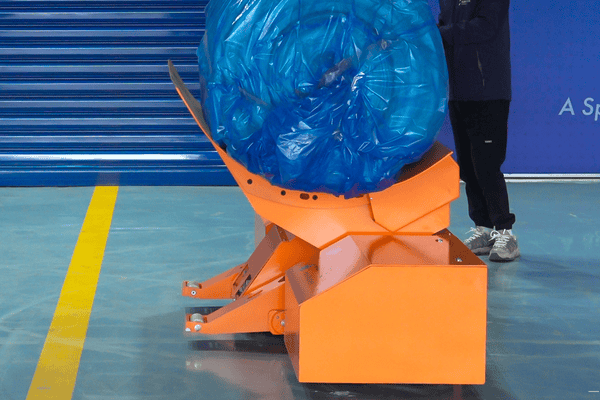As the world pays more attention to sustainable development, the textile industry is also seeking more environmentally friendly and efficient production methods. Under this trend, electric warp beam trolley is becoming an important booster for textile companies to move towards green manufacturing with its advantages of zero emission, low noise, energy saving and high efficiency.
Environmental Challenges In the Textile Industry
The textile industry usually faces the following environmental challenges during the production process:
1. High carbon emissions: Traditional fuel equipment (such as diesel forklifts) emit a large amount of carbon dioxide (CO₂) during transportation, increasing the carbon footprint.
2. High energy consumption: A large number of mechanical equipment relies on fossil fuels or high-energy electricity, resulting in energy waste.
3. Serious noise pollution: Traditional handling equipment (such as internal combustion engine forklifts) is noisy, which not only affects the workshop environment, but may also affect the health of workers.
4. Air quality issues: The exhaust gas generated by fuel equipment contains pollutants such as particulate matter, nitrogen oxides (NOx) and carbon monoxide (CO), which affects the air quality in the workshop and surrounding areas.
Faced with these challenges, textile enterprises are in urgent need of a more environmentally friendly and efficient handling solution, and electric warp beam trolleys are an ideal choice.
Electric Warp Beam Trolley "Green" Advantages
(1) Zero Emission, Reduced Carbon Footprint
Electric warp beam trolleys are battery-driven and do not emit carbon dioxide, nitrogen oxides or particulate matter during operation. Compared with traditional diesel equipment, they significantly reduce carbon footprints and enable textile enterprises to meet low-carbon environmental protection standards.
(2) Low Noise, Optimized Working Environment
Traditional diesel handling equipment usually produces noise at 85-100 decibels. Long-term exposure to such an environment will affect workers' health. Electric warp beam trolleys usually produce noise below 60 decibels, which is quieter and greatly optimizes the workshop working environment.
(3) High Efficiency and Energy Saving, Reduced Operating Costs
Lower energy consumption: Electric drive systems are more energy-efficient than fuel equipment, reducing energy loss.
Intelligent battery management: Many electric warp beam trolleys are equipped with intelligent battery management systems (BMS) that can optimize charging strategies, extend battery life, and further reduce costs.
Lower maintenance costs: Electric axle loaders do not have a complex internal combustion engine structure and do not need to replace engine oil, fuel filters, etc., which reduces maintenance costs.
(4) Intelligent Operation and Improved Production Efficiency
Modern electric axle loaders are equipped with intelligent functions such as EPS electronic power steering system, stepless speed control, hydraulic lifting system, etc., which make handling more accurate and efficient, reduce human errors, and improve production efficiency.

How Do Electric Warp Beam Trolley Help Textile Enterprises Achieve Sustainable Development?
(1) Support Green Manufacturing and Comply with Environmental Protection Policies
Globally, governments are promoting carbon neutrality and green manufacturing, and many countries have formulated strict environmental protection regulations for high-carbon emission industries. For example:
The European Union has implemented the Carbon Emission Trading System (ETS) to require companies to reduce carbon emissions.
China has proposed the goal of "carbon peak and carbon neutrality" to encourage companies to adopt low-carbon technologies.
The United States strictly restricts industrial pollution emissions in the Clean Air Act.
The use of electric axle loaders can effectively reduce the carbon emissions of enterprises, help enterprises comply with environmental protection regulations, avoid penalties for excessive emissions, and enhance the social responsibility image of enterprises.
(2) Enhance Enterprise Competitiveness
Globally renowned brands such as Nike, H&M, and Zara have begun to require suppliers to adopt green production models, including:
Reducing carbon emissions
Using clean energy
Optimizing production processes to reduce environmental impact
If textile companies can use green equipment such as electric axle loaders in the production process, they can not only obtain environmental certification, but also enhance brand competitiveness and attract more international orders.
(3) Reduce Workers' Occupational Disease Risks
The exhaust gas pollution, noise pollution and vibration impact of fuel equipment will pose a potential threat to workers' health, such as:
Long-term inhalation of exhaust gas may cause respiratory diseases
Continuous high noise environment may cause hearing damage
Mechanical vibration may cause musculoskeletal injuries
The low noise and zero emission design of electric axle loaders can help improve workers' working environment, reduce occupational disease risks, and improve employee satisfaction.
(4) Reduce Energy Consumption and Reduce Operating Costs
Traditional diesel equipment consumes about 3-5L of fuel per hour, while the electricity cost of electric equipment is less than 1/3 of diesel. In the long run, the use of electric axle loaders can significantly reduce energy expenditures.
Electric axle loading vehicles are easy to maintain and do not require replacement of engine oil, fuel filter, etc., which greatly reduces maintenance costs and downtime.
Future Outlook
With the development of battery technology, artificial intelligence, and the Internet of Things, future electric axle loading vehicles will be more intelligent and efficient, further promoting the green transformation of the textile industry.
(1) Battery Technology With Longer Battery Life
Future electric axle loading vehicles will use solid-state batteries or fast-charging lithium batteries to achieve longer battery life, reduce charging times, and improve work efficiency.
(2) Intelligent Networking and Remote Management
The application of Internet of Things technology enables electric axle loading vehicles to:
Real-time monitoring of battery status, running trajectory, and equipment health
Optimize transportation paths through data analysis to improve energy utilization
Remote maintenance and diagnosis to reduce downtime
(3) Automated Transportation to Improve Production Efficiency
In the future, electric axle loading vehicles may be combined with AGV (automatic guided vehicle) or AMR (autonomous mobile robot) to achieve unmanned transportation and intelligent scheduling, further improving the level of automation.
Conclusion
Driven by the global carbon neutrality goal, electric axle loading vehicles have become an important tool for textile enterprises to move towards green manufacturing. It can not only reduce carbon emissions and optimize the working environment, but also help enterprises meet the requirements of the international market for sustainable production and improve their competitiveness.
In the future, with the continuous advancement of technology, electric axle loading vehicles will become more intelligent and efficient, and become an important driving force for the green transformation of the textile industry. If your company is looking for efficient, environmentally friendly and sustainable handling solutions, electric axle loading vehicles are undoubtedly the best choice!




